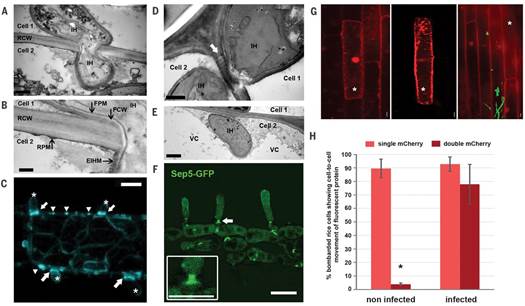Science报道最新突破:阻止稻瘟病蔓延
来源:Science
作者:Wasin Sakulkoo等
时间:2018-04-17

稻瘟病是水稻重要病害之一,主要为害叶片、茎秆、穗部,可引起大幅度减产,严重时减产40%~50%,甚至颗粒无收。每年因稻瘟损失的大米足够养活6000万人。病菌以分生孢子和菌丝体稻谷上越冬。翌年产生分生孢子借风雨传播到稻株上,萌发侵入寄主向邻近细胞扩展发病,形成中心病株。多年来,科学家们一直未曾查明,致病菌的侵入性菌丝(hyphae)到底是如何从一个细胞扩散到另一个细胞。英国埃克塞特大学(University of Exeter)领导的一个国际研究小组在《Science》发文,解开了真菌在水稻叶片中的扩散谜团。
文章阐述了真菌(Magnaporthe oryzae)如何巧妙地自我挤压通过植物细胞之间的胞间连丝(plasmodesmata)。“这是一个令人兴奋的突破,我们观察到真菌能跨水稻细胞偷偷移动,逃避植物免疫系统识别,”通讯作者Nick Talbot FRS教授说。
“这明显抑制了胞间连丝的免疫反应,在通过这样一个狭小空间时,真菌主动压缩了自己。而这一切都是由一个单一的调节蛋白控制实现的,真是一项了不起的壮举。”
研究人员运用化学遗传学方法突变Pmk1后,发现真菌被限制在了单个细胞内而无法转移。Pmk1调节真菌分泌抑制宿主免疫防御的效应蛋白表达,阻止了胞间连丝内活性氧的生成和过度的胼胝质(callose)沉积。此外,Pmk1还控制菌丝收缩,限制了真菌的自我压缩,导致无法通过胞间连丝进行跨细胞转移。
Pmk1编码一种被称为促分裂原活化蛋白(mitogen-activated protein,MAP)激酶的真菌酶类,由于它是负责调控稻瘟病侵入性生长的关键,研究小组希望将这种酶作为靶点,进一步确定这种毁灭性疾病的分子基础。(来源:生物通 伍松)
A single fungal MAP kinase controls plant cell-to-cell invasion by the rice blast fungus
Abstract Blast disease destroys up to 30% of the rice crop annually and threatens global food security. The blast fungus Magnaporthe oryzae invades plant tissue with hyphae that proliferate and grow from cell to cell, often through pit fields, where plasmodesmata cluster. We showed that chemical genetic inhibition of a single fungal mitogen-activated protein (MAP) kinase, Pmk1, prevents M. oryzae from infecting adjacent plant cells, leaving the fungus trapped within a single plant cell. Pmk1 regulates expression of secreted fungal effector proteins implicated in suppression of host immune defenses, preventing reactive oxygen species generation and excessive callose deposition at plasmodesmata. Furthermore, Pmk1 controls the hyphal constriction required for fungal growth from one rice cell to the neighboring cell, enabling host tissue colonization and blast disease.
原文链接:http://science.sciencemag.org/content/sci/359/6382/1399.full.pdf




